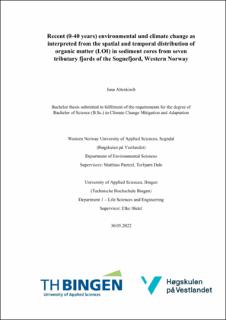| dc.description.abstract | Over the past 10 years, various sediment cores have been retrieved in seven tributary fjords of the Sognefjord, Western Norway, namely the Fjærlandsfjord, the Sogndalsfjord, the Barsnesfjord system, the Ikjefjord, the Arnafjord system, the Nærøyfjord and the Aurlandsfjord. As a standard procedure the organic matter content has been analysed, using the method called ³loss-on-ignition´ (LOI). The occurrence of organic matter in the respective fjords basins is used in this thesis to get a signal of environmental and climate change over the past four decades. Possible influencing factors for altering environmental conditions in the fjord systems are considered to be hydropower, man-made construction work and climate change. The north and south side location of the tributary fjords of the Sognefjord plays a distinct role regarding the glacial influence from the Jostedalsbreen on the hydrographical and meteorological variables influencing the fjord systems. Spatial and temporal variations in the LOI content of the sediment samples of the tributary fjord basins of the Sognefjord can be observed. The overall trend states an increase in LOI concentrations since the 1980s until today for the north-located tributary fjords, whereas the southern tributary fjord basins experience an overall decrease in the LOI development. The variations can be mainly explained by the link to climate change and glacial impact on the northern side of the Sognefjord, resulting in more runoff and primary production, and the link to human-induced environmental change through hydropower, resulting in significantly less runoff and primary production on the southern side of the Sognefjord. Unique local fjord features, such as oxygen availability, are not the major controlling factor for the observed trend. The regional influence of the northern and southern location outweighs the intended individuality of each tributary fjord basin of the Sognefjord. A simple box model has been developed to illustrate the influencing processes and factors on the organic matter supply system. | en_US |

